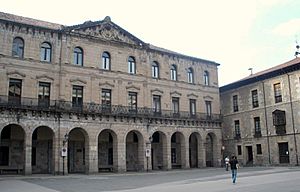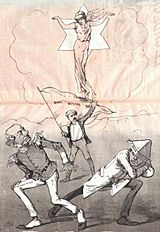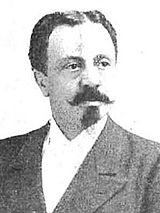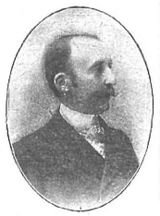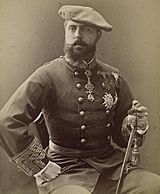Ramón Altarriba y Villanueva facts for kids
Quick facts for kids
Ramón Altarriba y Villanueva
|
|
|---|---|
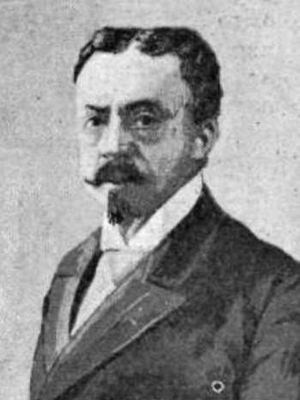 |
|
| Born |
Ramón Altarriba y Villanueva
30 August 1841 Bayonne, France
|
| Died | 1 April 1906 (aged 64) Madrid, Spain
|
| Cause of death | war |
| Nationality | Spanish |
| Citizenship | spanish |
| Occupation | landowner |
| Known for | politician |
| Political party | Carlism |
Ramón Altarriba y Villanueva (1841–1906) was an important Spanish politician, soldier, and landowner. He was also known as the 1st Count of Altarriba and the 24th Baron of Sangarrén. Ramón was a member of the Carlist political group, which supported a different royal family for Spain.
During the Third Carlist War, he led Carlist army units. He was elected to the Spanish parliament, called the Cortes, twice. He served from 1879 to 1881 and again from 1886 to 1890. In his later years, he became a leader for the Carlist party in the region of Old Castile. He also had a lot of influence in Gipuzkoa because he owned a lot of land there.
Contents
Ramón's Family and Early Life
Ramón Altarriba y Villanueva was born into a very old and respected noble family from Aragon, a region in Spain. His family had been important for centuries. They held the title of Baron of Sangarrén since the 1300s and Count of Robres since the 1700s.
His paternal grandmother, María Bernarda Colón Serra, was a descendant of the famous explorer Christopher Columbus. Ramón's father, José de Altarriba y Colón de Larreátegui, was also a Carlist supporter. Ramón's mother, María Pilar Villanueva y Altarriba, was also from Aragon.
The family lived in Bayonne, France, possibly because many Carlists had to leave Spain after the First Carlist War. Ramón was one of eight children. His older brother, José María, also became involved in Carlist activities.
When Ramón was young, he moved from France to Spain. He studied at the Real Seminario Científico Industrial in Bergara, a well-known school in Gipuzkoa. He started there in 1854, but it's not clear when he finished his studies.
Ramón Altarriba y Villanueva married Rosa Guerra y Serbi. She passed away in 1875, and they did not have any children together. Later, he married María de la Blanca Porcel y Guirior (1859-1940). She came from a noble family with roots in Gipuzkoa and Andalusia.
María inherited titles from her father, becoming the 7th Marchioness of Villa Alegre and San Millán. This made Ramón a "marqués consorte," meaning he was a marquis because of his wife. They had two sons, Ramón and Jaime. Jaime Altarriba y Porcel (1884–1936) became a military officer and also an active Carlist.
Ramón's Military Career
In 1859, when the First Moroccan War began, young Ramón volunteered for the army. He joined an infantry unit and went to Ceuta in December 1859. He fought in many battles against Moroccan troops.
He likely took part in the battle of Castillejos and the battle of Cabo Negro. For his brave service, Ramón was given the Laureate Cross of Saint Ferdinand, a very important military award. He was also promoted to lieutenant. After the war, his unit returned to Spain. Ramón continued his military career for several years.
After the Revolution of 1868, Ramón left the army but rejoined in 1871. When the First Spanish Republic was declared, he joined the Carlists who were planning a rebellion. When the Third Carlist War started, he was already part of their army.
He was sent to the Northern Front and led a volunteer battalion in Biscay. His unit successfully took control of the Durango area in 1873. He was promoted to colonel and later led a brigade. He took part in the siege of Bilbao in 1874. He also led his unit in the battle of Somorrostro.
Ramón was given the honor of accepting the surrender of a famous Republican army unit in Portugalete. He also fought in skirmishes around Bilbao. Later, he was put in charge of the Carlist forces in Alto Aragón. He organized and led the "Battalion of Almogávares de la Virgen del Pilar." This unit fought in battles in Navarre in 1875.
Towards the end of the war, Ramón faced an investigation, but he was cleared of all charges. He was then promoted to brigadier. He was an adjutant (an assistant) to Carlos VII, the Carlist claimant to the throne. For his service, he was given the title of Count of Altarriba.
Politics in the Restauración Period
After the war, Ramón settled in Gipuzkoa in 1878, where he managed his wife's large land estates. These estates made them one of the wealthiest families in Gipuzkoa. His wife also owned land in Álava and Andalusia. In 1878, Ramón's older brother gave him the title of Baron of Sangarrén, making Ramón the 24th Baron.
Ramón was worried about the future of Carlism after the war. In 1878, he wrote to Carlos VII, asking him to appoint a strong political leader. When civil rights were restored in Gipuzkoa in 1879, Ramón supported the idea of Carlists participating in elections.
Carlos VII allowed some Carlists to run as individuals. Ramón ran in the Azpeitia district and was the only Carlist to win. He then moved to Madrid. He tried to be re-elected in 1881 but lost.
The 1880s saw disagreements within the Carlist movement. Some Carlists, called "immovilistas," wanted to stick strictly to old ways. Others, including Ramón, were "aperturistas," meaning they were open to working within the new political system. This led to a big conflict, even fought through newspapers. To counter the "immovilista" newspapers, Ramón founded a satirical weekly newspaper in Madrid called El Cabecilla.
In 1884, Ramón wanted to run in the elections again, but the "immovilista" leader ordered Carlists not to participate. Ramón, being loyal to his king, withdrew. Two years later, in 1886, he got permission from Carlos VII and was re-elected from Azpeitia. He was the only Carlist in the Spanish parliament at the time. When he took his oath, he publicly declared that he considered Carlos VII the true king of Spain.
As the disagreements within Carlism grew, Ramón also had a conflict with the Carlist leader of Aragon. Carlos VII had to step in to stop the dispute. Ramón was criticized by some Carlist newspapers, but he remained loyal to Carlos VII during a major split in the party.
Ramón's Political Influence
After a group called the Integristas left the Carlist party, Ramón became one of the most important Carlist politicians. He was the only Carlist member of parliament and one of the few nobles in the party. However, he sometimes had difficult relationships with other Carlist leaders. Some accused him of being jealous and trying to control Gipuzkoa.
In 1888, he was offered a high position in a new Carlist committee in Madrid, but he refused, perhaps sarcastically saying he wasn't worthy.
In 1889, Carlos VII began to create formal party structures. Ramón was chosen to represent the region of Castilla la Vieja (Old Castile) in the main Carlist committee. He again called for a strong leader to guide the party. The liberal newspapers even suggested he might be one of four leaders guiding the movement. Ramón's importance was confirmed when he was invited to the wedding of Carlos VII's daughter in Austria.
Even though his newspaper, El Cabecilla, sometimes made fun of the Marquis of Cerralbo, Ramón quickly congratulated Cerralbo when he was appointed the new main Carlist leader in 1890.
Before the 1891 elections, the Carlists decided to officially participate for the first time since the Restoration. Ramón had to step aside in Azpeitia for another rising Carlist leader. He ran in two other districts but lost in both. After this defeat, he did not run in any more elections.
Later Years and Business Ventures
After leaving parliament, Ramón had more time for his private businesses. His properties were spread across Spain, from Gipuzkoa to Castile and Andalusia. Besides managing his family estates, he invested in mining and metalworking. He co-owned rights to a copper mine near Madrid.
In 1893, he took control of "La Fe" mineral springs, renaming them "Mudarra," and operated them until 1900. He also owned shares in a paper mill in the Lérida Province and was vice-president of a company in Granada that worked on irrigation projects.
Within the Carlist party, Ramón formally led the region of Castilla la Vieja. However, because he owned so much land, he had the most influence in Gipuzkoa. Landowners like him were very important for gaining support in rural areas and helping to fund the local Carlist party. Thanks in part to his efforts, Gipuzkoa became a strong Carlist area in the 1880s and 1890s.
In the early 1890s, some Carlists saw Ramón as a "fractious" (difficult) member. Some reports suggest he supported a more militant group that wanted to take up arms. However, other events show him working closely with the more peaceful Marquis of Cerralbo. They traveled together across Spain, giving speeches.
When the colonial crisis of 1897 happened, Ramón seemed to consider strong action. He welcomed General Weyler, who was dismissed from Cuba, with shouts of "Long live Spanish Cuba!" and "To horse, my general!" However, during the war, Ramón also denied rumors of another Carlist uprising, calling them "a fable."
During "La Octubrada," a series of small Carlist revolts in October 1900, Ramón was in Paris. This didn't stop him from being detained by the Guardia Civil in Bilbao the next month. In 1902, when there were more rumors of Carlist military action, Ramón publicly spoke against it.
Newspapers reported that he was a Carlist candidate for the 1903 elections, but he was not mentioned as running later. Ramón Altarriba y Villanueva died on April 1, 1906, after suffering from a long illness. His funeral was attended by the Carlist political leader of the time, Matías Barrio y Mier.
See also
 In Spanish: Ramón de Altarriba para niños
In Spanish: Ramón de Altarriba para niños
- Carlism
- Electoral Carlism (Restoration)
- Hispano-Moroccan War (1859–60)
- Third Carlist War
- Enrique de Aguilera y Gamboa
- Matías Barrio y Mier


